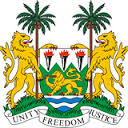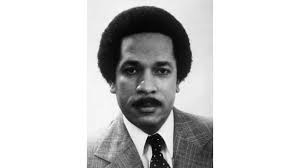
On April 19, 1989, Sierra Leone marked the 18th anniversary of its transition to a republic. Originally gaining independence from British colonial rule on April 27, 1961, Sierra Leone became a republic on April 19, 1971, when it adopted a new constitution and replaced the British monarch with an executive presidency. Republic Day became a national celebration, honoring Sierra Leone’s sovereignty, democratic aspirations, and the contributions of its people to post-independence nation-building. The 1989 celebrations took place amid ongoing economic and political challenges, but the spirit of pride and resilience remained strong among Sierra Leoneans both at home and abroad.

Max Robinson (1939-1988) overcame racial barriers in the media industry when he became the first African-American television anchor in Washington, D.C., and again when he joined ABC’s World News Tonight as a cohost in 1978. Robinson fought for racial equality and more positive portrayals of African Americans throughout his career. Robinson was a founder of the National Association of Black Journalists.
Robinson began his television career in 1959, when he was hired for a news job in Portsmouth, Virginia. He had to read the news while hidden behind a slide of the station’s logo. One night, Robinson had the slide removed, and was fired the next day for soing so. He later went to WRC-TV in Washington, DC, and stayed for three years, winning six journalism awards for coverage of civil-rights events such as the riots that followed the 1968 assassination of Dr. Martin Luther King, Jr. It was also during this time that Robinson won two regional Emmys for a documentary he made on black life in Anacostia entitled The Other Washington.
In 1969, Robinson joined the Eyewitness News team at WTOP-TV in Washington, D.C. Robinson was teamed with anchor Gordon Peterson, becoming the first African-American anchor on a local television news program, and the newscast took off. During that time, Robinson was so well-liked by viewers that when Hanafi Muslims took hostages at the B’nai B’rith building in Washington they would speak only with Robinson.
In 1978, when Roone Arledge was looking to revamp ABC News’ nightly news broadcast into World News Tonight, he remembered Robinson from a 60 Minutes interview, and hired him to be a part of his new three-anchor format. Robinson would anchor national news from Chicago, while Peter Jennings would anchor international news in London and Frank Reynolds would be the main anchor from Washington. Robinson became the first black man to anchor a nightly network news broadcast. The three-man co-anchor team was a ratings success, and launched spoofs regarding how the three would pitch stories to each other during the telecast by saying the other’s name.
Robinson’s ABC tenure was marked by conflicts between himself and the management of ABC News over viewpoints and the portrayal of African-American America in the news. Robinson was known to fight racism at any turn and often felt unworthy of the admiration he received and was not pleased with what he had accomplished. Together with Bob Strickland, Robinson established a program for mentoring young black broadcast journalists.
After Reynolds died in 1983, and shortly afterward Jennings was named sole anchor of World News Tonight. Robinson was relegated to the weekend anchor post, as well as reading hourly news briefs. He left ABC in 1984 to become the first black anchor at WMAQ-TV in Chicago. He retired in 1985.
On April 19, 1960, a landmark study by the National Education Association (NEA) revealed that more than 30,000 Black teachers and principals had lost their jobs across 17 Southern and Border states since the 1954 Brown v. Board of Education decision. The very ruling that mandated desegregation in schools had also, paradoxically, displaced thousands of Black educators due to discriminatory hiring practices by newly integrated school systems. Many white school boards refused to retain Black teachers, citing fabricated qualifications or eliminating their positions altogether. This mass job loss had lasting effects on Black communities, depriving students of culturally affirming role models and destabilizing Black middle-class economic foundations.
On April 19, 2002, commemorations across the United States honored the role of African American soldiers in the American War of Independence, especially those who stood at Lexington in 1775. The colonial militias that engaged British forces on that day formed the first integrated military units in American history. Among them were African American minutemen like Prince Estabrook, who fought side by side with white colonists during the opening battle of the Revolutionary War. These early acts of unity challenged the racial norms of the time and underscored the Black contribution to American independence from the very beginning.
On April 19, 1977, author and historian Alex Haley received a special Pulitzer Prize for his groundbreaking work “Roots: The Saga of an American Family.” The book, published in 1976, traced Haley’s ancestry back to Kunta Kinte, an African man kidnapped into slavery, and told the generational story of his descendants in America. Roots became a cultural phenomenon, inspiring a major television miniseries watched by over 130 million viewers. Haley’s work brought the horrors of slavery and the resilience of Black families into the American consciousness, sparking interest in genealogy and redefining historical storytelling through a Black lens.
On April 19, 1971, Reverend Walter E. Fauntroy was sworn in as the first elected Congressional delegate from the District of Columbia since Reconstruction. A civil rights leader and close associate of Dr. Martin Luther King Jr., Fauntroy had played a pivotal role in organizing the 1963 March on Washington. His election marked a turning point in D.C.’s fight for political representation, as residents of the capital—long denied voting rights in Congress—finally regained a voice on Capitol Hill. Though non-voting, Fauntroy used his platform to advocate for civil rights, D.C. statehood, and anti-poverty initiatives throughout his 20-year tenure.
On April 19, 1960, Major General Frederic E. Davidson made history by assuming command of the Eighth Infantry Division in West Germany, becoming the first African American to lead a full U.S. Army division. At a time when the military was still grappling with the legacy of segregation, Davidson’s promotion marked a significant milestone in the integration and advancement of Black officers within the armed forces. His leadership in Europe not only broke racial barriers but also paved the way for future generations of African Americans to rise through the ranks of military command.
On April 19, 1960, civil rights attorney Z. Alexander Looby’s Nashville home was destroyed by a dynamite bomb in retaliation for his legal defense of 153 students arrested in peaceful sit-in demonstrations. Though Looby and his wife survived unharmed, the attack marked a chilling escalation in violent resistance to the growing civil rights movement. That same day, over 2,000 outraged students—led by young activists including John Lewis and Diane Nash—marched silently to Nashville’s City Hall. When confronted, Mayor Ben West admitted that racial discrimination was morally wrong, paving the way for desegregation of Nashville’s lunch counters. The bombing and protest became a pivotal moment in the Southern student-led resistance.
On April 19, 1910, the National Urban League was officially founded in New York City. The organization emerged from the merger of three groups: the Committee on Urban Conditions Among Negroes, the National League for the Protection of Colored Women, and influences from the Niagara Movement. Its mission was to support African Americans migrating from the rural South to northern cities—helping them access fair employment, housing, and education. Over the decades, the Urban League became a leading civil rights organization, advocating for economic justice, workforce development, and racial equity across the United States.
On April 19, 1866, thousands of African American citizens in Washington, D.C. held a monumental celebration marking the abolition of slavery in the United States. Between 4,000 and 5,000 people gathered near the White House to hear President Andrew Johnson deliver remarks. The historic procession, led by two Black military regiments, proceeded up Pennsylvania Avenue to Franklin Square. The crowd was filled with formerly enslaved people, Union veterans, religious leaders, and children—many waving flags or holding banners with messages of freedom and hope. This Emancipation Day parade symbolized both triumph over bondage and a demand for full citizenship in post-Civil War America.
On April 19, 1837, Cheyney University of Pennsylvania was established as the Institute for Colored Youth, making it the first Historically Black College and University (HBCU) in the United States. Founded in Cheyney, Pennsylvania, the school was created through a $10,000 endowment by Quaker philanthropist Richard Humphreys to provide education for African Americans. Originally focused on teacher training, Cheyney played a vital role in uplifting generations of Black leaders, educators, and intellectuals. Its legacy paved the way for future HBCUs and remains a cornerstone of Black academic history.
On April 19, 1775, the first shots of the American Revolutionary War were fired at the Battles of Lexington and Concord. Among the colonial Minutemen who confronted British troops that day were both Black and white soldiers, fighting side by side for freedom. Notably, Peter Salem, a formerly enslaved African American, stood at the front lines and later became a recognized patriot hero for his service at the Battle of Bunker Hill. The participation of Black militiamen at Lexington and Concord is a powerful reminder that African Americans have defended American ideals from the nation’s very first battle — even while denied full liberty themselves.
On April 19, 1971, Sierra Leone officially became a republic, marking a significant step in its post-colonial evolution. The West African nation had previously gained independence from British rule on April 27, 1961, but remained a constitutional monarchy under Queen Elizabeth II. A decade later, under Prime Minister Siaka Stevens, the country adopted a republican constitution and Stevens became Sierra Leone’s first executive president. This shift reflected a broader movement across Africa to assert full political sovereignty and national identity following centuries of colonial domination.
© 2025 KnowThyHistory.com. Know Thy History